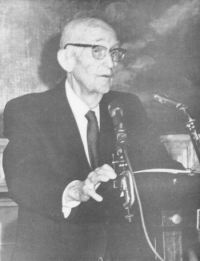Arizona Senator Carl Hayden
President Pro Tempore of the United States Senate
U.S. Capitol Kino Statue Dedication
"I am in the position of accepting Arizona's second and final statue, that of Eusebio Francisco Kino, to be enshrined with an exclusive group who were makers of our Nation's history."
Address by Arizona Senator Carl Hayden
President Pro Tempore of the United States Senate
Acceptance of the Statue
Mr. JAMES M. MURPHY: Now I would like to present a gentleman who 35 years ago in this same historic hall, on behalf of Arizona, presented its first statue of Gen. John C. Greenway to the people of the United States. He was the junior Senator from Arizona. Today, 35 years later, as a maker of history, he again is present to accept the statue of Padre Eusebio Kino from Governor Goddard on behalf of the people of the United States. Ladies and gentlemen, the Honorable Carl Hayden, Senator from Arizona.
Hon. CARL HAYDEN: Mr. Chairman, members of the Arizona congressional delegation, Governor Goddard, members of the family of Father Kino, citizens and friends of Arizona: This is a notable occasion. For me, it has particular significance. On May 24, 1930, I - as a Senator from Arizona - had the honor of presenting to the Nation the statue 'of Gen. John Campbell Greenway. Today, as President Pro Tempore of the Senate, I am in the position of accepting Arizona's second and final statue, that of Eusebio Francisco Kino, to be enshrined with an exclusive group who were makers of our Nation's history.
Many fine remarks have already been made concerning this great missionary and explorer, and I want to bring alive for a moment the words of Father Kino himself when he made his second visit to what is now Arizona in November of the year 1697.
Imagine yourself to be part of his military escort as he describes the trip:
"Travelling always by the valleys of the Rio de Quiburi (the San Pedro River), we arrived at the large river, or Rio de Gila. And following its bank and its very large cottonwood groves, after travelling three days' journey to the west, we arrived at the Casa Grande, and its neighboring rancherias. As we journeyed we always had on the right hand and in sight but on the other bank of the river, the very extensive Apacheria.
"The soldiers were much delighted to see the Casa Grande." (He afterwards described it as "a four-story building, as large as a castle and equal to the largest church in these lands of Sonora.") "We marveled at seeing that it was about a league from the river without water, but afterward we saw that it had a large aqueduct with a very great embankment, which must have been three cubits high and six or seven wide, wider than the cause way of Guadelupe at Mexico. This very great aqueduct, as is still seen, not only conducted the water from the river to the Casa Grande but at the same time, making a great turn, it watered and enclosed a series of fields.
"With ease, also, one could now restore and roof the large dwelling and repair the great aqueduct, for there are nearby six or seven settlements of Pimas, Sobaipuris, all of whom in all places received us very kindly, with crosses and arches erected and with many of their eatables, and with great pleasure to themselves, gave us many little ones to baptize. On one occasion, when several of our horses had been scattered and lost, they at once went in search of them, nor did they give up until they had collected them all for us."
Here then, we have a fortunate glance at the Arizona of nearly three centuries ago and of the man who first made it known to the civilized world -a kindly man of extraordinary intellect, unwavering in purpose and possessed of faith that inspired faith in others.
In accepting this statue for Americans everywhere, I thank God for blessing this country of ours with men like Father Kino. They are our everlasting heritage.
